China

It is the world’s most populous country and the leading manufacturer of goods. More than 90% of the globally produced household appliances contain the country of origin label Made in China.
China is increasingly growing in confidence as a superpower, casting out the established leaders in the area of economics and politics.
However, despite the growing ambitions and economic strength, the country has remained a fabulous spot on the planet worth visiting by everyone who begins their acquaintance with the world.

General Information
The history of modern China began on October 1, 1949, when the republic gained its independence. Before turning to a current industrial and political monster, Celestial Empire has come a long way. According to different sources, the Chinese civilization arose around 5,000 years ago.
Historical Background
People and their needs, personal, physical, and psychological well-being were under particular attention in ancient times. Philosophical and scientific schools were established along with conducting researches and promoting engineering inventions. We still refer to prominent philosophers of antiquity like Confucius and Laozi and get astonished by the wisdom and accuracy of their rhetoric.
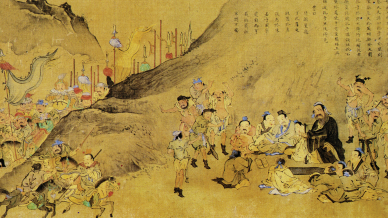
A Chinese painting shows the conversation between Confucius and his disciples
The Chinese have invented the compass, gunpowder, paper, and book printing, without which humankind would have groped in the darkness of unenlightenment. We clean our teeth with a toothbrush, drink beer, enjoy the taste of a quality tea, amuse ourselves by playing board games like mahjong and go, use toilet paper, steam cooker, and many other conventional things. But we never reflect on their origins. They came into existence in this East Asia country where the inquisitive mind, the spirit of innovation, and pursuit of excellence have always been honoured.
The imperial dynasties reigned in China from ancient times till the beginning of the 20th century, and the Qing were the last ones. The period of their rule began in 1644 and ended in 1944. During that era, the country underwent economic and political decline due to endemic corruption, low taxes, and the half-empty treasury. The situation worsened when China lost a considerable part of its economic independence during the Opium Wars with the powerful European countries at the end of the 19th century. The Chinese rulers were forced to sign inequitable and enslaving contracts with the winning countries.
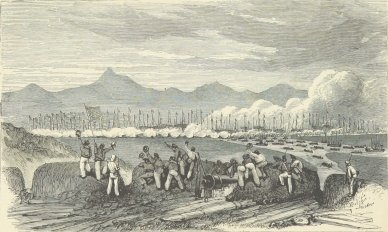
British forces battle Chinese junks on Escape Creek during the second Opium War
Wealth, global influence, and prosperity became the things of the past. The Chinese Empire was dramatically sliding into poverty, which eventually led to a series of internal rebellions and wars. The defeat in the first war with Japan was the final straw in the endless ordeal encountered by China. All attempts made by the national elites to improve economics through stringent reforms were not successful.
In 1908, Empress Dowager Cixi passed away. After her death, the reformation in the country stopped as a result of court decisions, and the political situation got out of control. Rebellions and uprisings that broke out one after another escalated into the 1911 Xinhai Revolution. In a year, the last emperor abdicated the throne.
In 1912, the Kuomintang was formed as the first of the two political spectra in China. Ten years later, the Chinese Communist Party (CCP) emerged and even collaborated with the nationalist force. However, in four years, Kuomintang leader Chiang Kai-shek did everything possible to oust the communists from power. He even became the President of China and got the official recognition of the world’s leading countries.
Nonetheless, the communists were not willing to give up: they rose in rebellions against the Kuomintang from time to time. Many problems stemmed from the aggression of an old enemy — Japan. Those things bled the country dry, and before the growing threat of war with Japan, Chiang Kai-shek was forced to create a union with the Communist Party. He put his ambitions and malice towards the communist ideas on the back burner.
In 1937, the biggest fear of the Kuomintang leader became a reality. The war with Japan began and lasted eight years till the end of WWII. Japan lost and surrendered.
In 1949, the communists scored the major victories in the country. They managed to end the civil war and formed all the branches of power. On October 1, they declared the creation of the People’s Republic of China with Mao Zedong as the ruler and chairman of the Communist Party.
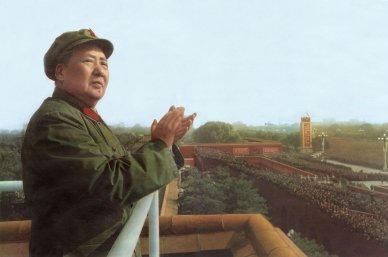
Mao Zedong
China chose the path of socialist development. The country encountered the immediate reforms and economic transformations modelled after the image of the USSR.
However, friendly relations continued for ten years only. At the end of the 1950s, a diplomatic conflict between the two countries arose. It led to the Sino-Soviet Border Dispute of 1969 and the severance of relations. At the beginning of the 1980s, the liaisons between the USSR and China recovered. That was at the time when Mao, the man sticking to his principles and ideology, died.
During the rule of Mao Zedong, the country encountered several risky undertakings initiated by Great Helmsman (the Communist Party leader got this respectful nickname from his fellow citizens). The first venture was the Great Leap Forward — the campaign of building economic power, which was quite questionable in terms of its reasonability and efficiency. The villagers of a billion-populous country were compelled to unite into communes. They would smelt cast iron right in their yards, disperse the sparrows invading the fields, and do other weird things, surprising the entire civilized world. China got locked in extreme poverty.
After that, the Cultural Revolution followed. Mao made an attempt not only to strengthen his leadership but to usurp the public authority. And he managed to do it. Those who did not conform were declared the enemies; they were either sent to penal camps for 20-30 years or were sentenced to torturous executions.
Mao died in 1976, and three years after his passing, the country experienced early improvements. Deng Xiaoping became the new leader. He was the forefather of the market economy in the nation driven to despair. His policy turned out to be a salvation for the enormously populated state. And what is more, it was supported by all the subsequent rulers of China — Jiang Zemin, Hu Jintao, and Xi Jinping (since 2012).
Now China is a real superpower with an impressive tempo of economic growth. Its GDP is the highest in the world: around $25 trillion.

Tesla Gigafactory in Shanghai
But the income of the population is not as high. The country holds the 85th position by the standard of living, but the pace of its development brings hope to see it in the top ten in the nearest future.
Geography
China is a country in East Asia. It borders Russia, Vietnam, Mongolia, PRC, Kazakhstan, Kyrgyzstan, Tajikistan, Afghanistan, Pakistan, India, Nepal, Myanmar, Laos, and Bhutan.
The marine borders stretch along the Pacific Ocean within the Yellow, East China, and South China Seas, the coasts of which lure with the pearls of beach recreation — Quingdao, Sanya (Chinese Hawaii), and Beidaihe.
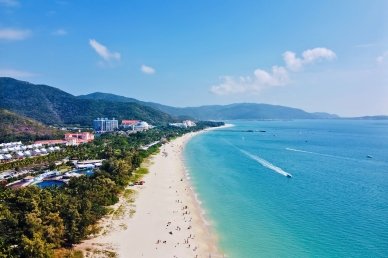
Beach in Sanya, Hainan, China
The country's terrain is predominantly mountainous: highlands and plateaus take around 70% of the territory and impact the moderate climate of some regions. The other parts are occupied with marginal lands or deserts.
Half and a billion Chinese people inhabit only 10% of their country — the cities and villages on the banks and valleys of the Yangtze and Yellow Rivers.
Tropics and subtropics — the favoured spot of the fans of beach sunbathing and thrill-seekers keen on diving and surfing — stretch along south and east. The duration of the high season may differ depending on the location of the resorts.
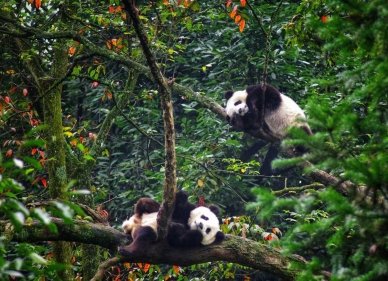
Giant pandas rest in their habitat in Ya'an, Sichuan province
For example, in Qingdao, it continues for a long time — from March to November, and in Sanya and Beidaihe — from July to September when the seawater temperature reaches +25°C. However, even in winter, it is not very cold — normally around +20°C.
In other regions of China, climatic conditions change dramatically. In the northern part, the temperatures may drop to -35°C and reach +20°C in winter and summer respectively.
Southern and eastern China often suffers from natural disasters like typhoons, tsunamis, floods, and droughts.
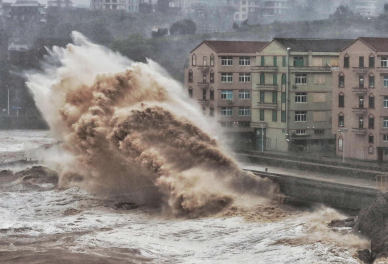
Waves crash against the seawall in front of buildings in Taizhou, East China's Zhejiang province
Population and Language
China is the world’s most populous country — there live around 1.5 billion people. The official language is Chinese, but it is spoken only by one billion citizens. The others use the languages of 55 ethnic minorities. The Chinese characters are the logograms called hanzi.
The official currency is the renminbi or the yuan, and its exchange rate in relation to the US dollar is 1:0.16, and the euro — 1:0.13.
The capital is Beijing that has a population of 22 million people. It is the second-most populous city after Shanghai (23.3 million). The third place is taken by Chongqing (14 million people). Interestingly, in each Chinese city, the mayor’s obligations are fulfilled by Party Committee Secretary.
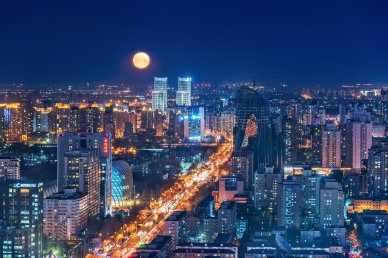
Beijing urban landscape
Directions
An excellent option for getting to China is air travel. There are both direct and transit flights to Beijing. Trips from the North American continent may take 10-14 hours, and from Europe and Australia — 9-11 hours.
The fares vary by the country of a departing flight. For example, flying from Toronto may cost around $2,000, from San-Fransico — $3,500-$5,000, from London — $3,500.
Generally, many planes land in Beijing Capital International Airport. Visitors to the city may get to its centre by bus, underground, or taxi. Daxing is the second international airport in Beijing, still under construction, which is expected to be finished no earlier than 2025. But the first line has already opened for arrivals.
The first underground train leaves at 6.30 a.m., and the last one — at 10.30 p.m. The fare is rather high — local currency equivalent of $4. The time interval between trains is 15 minutes.
There are also buses to the city centre running every 15 min; the fare is $3.
Taxi services are much more comfortable but expensive. If to pay for the meter running, it will cost $15-30, depending on the destination. Taxi drivers are truly artful individuals, and the ones in China are not an exception. So if you do not want to overpay, make sure that the driver has turned on the meter.
Travellers need a visa to enter the PRC, and its cost and type depend on the aim and length of the stay. Its obtaining is possible by applying to the embassy or agency firms, or right in the airport. The latter option is the easiest and very cheap, but suitable for groups of tourists. That is why follow the latest updates on visa application procedures.
Entry requirements to China, as to any other country, constantly change due to the coronavirus pandemic. That is why check everything out through the Ministry of Foreign Affairs website: https://www.mfa.gov.cn/ce/cohk//eng/fwxx/wgrqz/t1810116.htm.

Accommodation
Hotels and apart-hotels are the two types of accommodation most preferred by visitors to China. The cost is almost the same — around $40-$50 per night. However, the Chinese hospitality industry has some pitfalls that may tarnish the impressions left by the trip.
- Within the domestic network hotels, for example, 7 Days, smoking is allowed. Actually, China is a paradise for smokers: they do not run the risk of being fined and can smoke everywhere, even on a bus. The remaining smell of tobacco penetrates the walls, furniture, and carpets, so it is not much pleasure to stay in the rooms. We can only guess how children, non-smokers, pregnant women, and asthmatics feel there.
- The real star rating of the hotels in China seldom corresponds closely to the one that the hotel management has claimed, so if you want to get decent living conditions, choose only five-star hotels. However, this statement does not refer to the hotels of giant international networks.
- The staff can barely speak English, so you may encounter some inconveniences talking to the maids, receptionists, and other people who provide hotel services.
- Even the rooms of five-star hotels can be dirty, and no one makes the trouble of the dust found under the beds and soapy streaks in the bathroom.
- Surprisingly, not all the rooms have windows. That is why you should read the room descriptions very attentively before booking. The blinds may serve only as decorations and thus confuse you.
Besides, both hotels and apart-hotels ask for caution money, usually ¥300-¥400 ($45-$50). If the guests have not caused any damages while living in the room, they can get their money back.
Tip: leave the cash, and you will be able to get it immediately while check-out. If you have made a cashless transaction, you will need to wait for more than two months.
Below are several options of five-star hotels in China. Despite a high star rating, the prices are budget-friendly — $45-$50 per night:
- Lijiang Guiyuantianju Inn is an ethnic-style hotel in Lijiang, Yunnan. The rooms are clean and cosy, equipped with bathrooms and toilets, air-conditioning, and Wi-Fi. The staff speak English. The hotel is located near Old Town, and shops and supermarkets are within walking distance.
- Fulitai International Hotel Yantai is located in Shandong province. It offers European-style rooms with comfortable furniture, TV sets, Internet access, showers, and toilets. There is also a buffet and a restaurant serving Chinese national cuisine. The staff do not speak English.
- Barry Boutique Hotel Sanya (Hainan province), located a five-minute walk from Dadonghai beach, welcomes its guests with spacious and well-furnished rooms with necessary facilities. There are two restaurants and swimming pools within the territory.
- Shengyi Holiday Villa Hotel is another spot to accommodate in Hainan province. It is also located very close to the beach and offers rooms with furnished balconies, a swimming pool, and a restaurant within its area. The staff do not speak English.
- Lacosta Hotel is a beautiful hotel designed in a national-style interior in Sanya (Hainan). Trendy furniture and decor add to the unique comfort and allure of the rooms, which are also equipped with air-conditioning and have balconies that overlook the sea and bathrooms. There is a swimming pool and free Wi-Fi.
Apart-hotels are becoming increasingly popular among foreign tourists in China. These are luxurious suites in newly-constructed buildings leased to the letting agencies that find the tenants for the agreed charge.
It is always clean in such type of accommodation. There are quality towels, slippers, gowns, and all necessary appliances for having rest and cooking food. The apart-hotels are of various star ratings, but, as a rule, they correspond to the number of stars claimed. For example, in Shanghai, it is a five-star Green Court Serviced Apartment-Green City, and in Sanya, it is Albion Residence Haitang Bay Sanya. The other options are available through popular online services like https://www.booking.com/hotel/cn/ and others.
Exotic things are one of the peculiar features of China. So its visitors are provided with unusual offers even in the accommodation search. Just imagine a comfortable and economical stay in a bathhouse! It is a place where guests can get the services of nail art, pedicure, massage, and even a bed to sleep. A client does not get a separate room for spending the night, but a sleeping capsule instead. That is a cosy place with a soft mattress and fresh bed linen. The price is much lower in comparison with a traditional hotel room. Pod hotels have their own fans, and if you choose to accommodate there, the impressions left by Chinese hospitability will be overriding.
Places to See
China is an impressive mix of ultramodern trends and deeply-rooted patriarchy within the mentality, culture, architecture, and nature.
Great Wall of China
Acquaintance with the Chinese attractions should begin with the Great Wall of China, the most recognisable national symbol. The 9,000-km construction is its main part without the branch lines that stretch along the entire north of the country within the Yin mountain range. The Wall together with its branches spans over the uninterrupted 22,000 km. The segments are of different widths: in some places, they may range from five to eight metres. The heights also vary from six to ten metres.
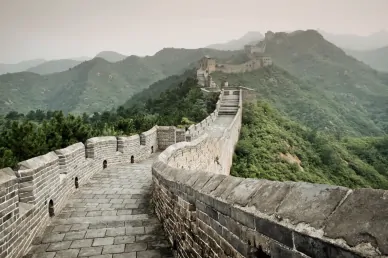
Great Wall of China
Thousands of tourists come here at any season of the year, and the majority of them are the Chinese themselves. At least once in their life, every citizen of China should see the Wall — the symbol of national mightiness and resilience. The scale and prestige of such trips can be compared with the Muslim pilgrimages to Mecca.
People get to the spot by expresses from Beijing. It takes 75 km to reach the Badaling section easily by buses and high-speed trains.
Shaolin
This functioning monastery at the peak of Songshan in Dengfeng county (Henan province) is the second legend of China that became well-known to the world from the 1990s action movies.
Chinese people consider this place their national pride. Its history began in the 5th century when Emperor Xiaowen ordered to erect the first Buddhist monastery, which encountered the dynasty wars for the emperor’s throne, invasions of intruders, and arsons.
The last fire in Shaolin occurred in 1928. At that time, the unique martial arts treatises were destroyed, and the monastery itself remained in ruins for the following 50 years.
The era of obscurity ended in the 1970s when the Chinese authorities decided to revive the monastery. The wushu and tai chi masters were gathered from all over the country to help seven monks who continued living in the remaining constructions and practicing martial arts.
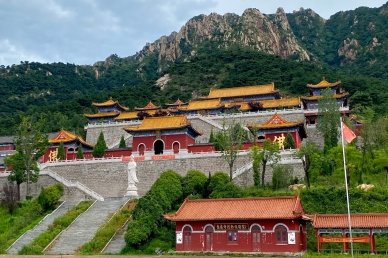
Shaolin Temple
Nowadays, Shaolin is a giant temple complex that has its school of martial arts. It takes around four and a half hours to get here by train from Beijing. Tourists may also travel to Shaolin by car or plane.
Temples
The adherents to Buddhist practices should definitely go to at least several Chinese temples. In Bejing, there are 36 of them! However, the most visited attractions for those who go on guided tours are Guangxiao (Guangzhou), the Temple of Confucius (Shanghai), Nanshan (Sanya), Zhenjue (Beijing), and A-Ma Temple (Macau).
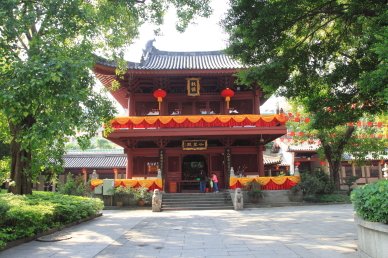
Guangxiao (Guangzhou)
The oldest are 1,700 years old, but all of them retain the legends of antiquity and the beauty of architectural canons of ancient China.
National Tea Museum
The third treasure of China is tea, without which the life of the country is inconceivable. It has been grown here for more than 2100 years and was used solely as a healing remedy at first. Drinking tea as an aromatic potion began later, during the reign of the Tang dynasty.
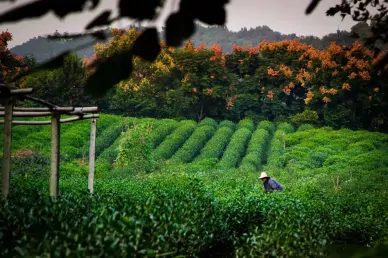
Tea plantation
During these two millennia, tea culture, its philosophy, techniques of presentation and drinking, and the requirements for a particular teaware have been formed. The Sage of the Tea Lu Yu was the first to have described those things in his monograph The Classic of Tea. The statue of Lu Yu is located right at the entrance to the Museum.
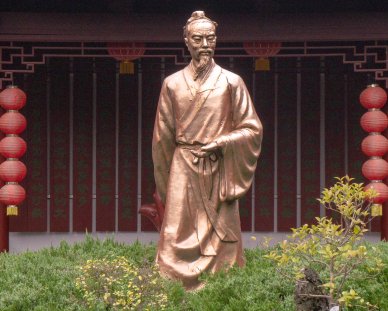
The statue of Lu Yu
The National Tea Museum has already operated for 30 years in Hangzhou (Zhejiang). It was constructed right in the middle of enormous tea plantations, occupying around four hectares of their territory. There are five halls dedicated to the history, teaware, tea planting, kaleidoscopes, and customs. Together, they form a comprehensive picture of tea as a drink and a significant phenomenon in the history and life of China.
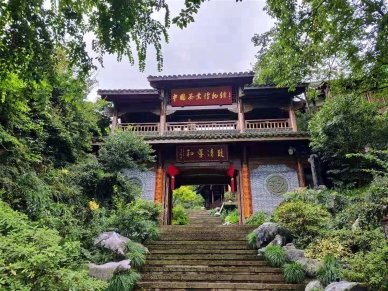
National Tea Museum
If you want to learn more about China’s national drink and take part in an impressive tea ceremony, get on the train to Tianjin Binhai in Beijing and buy a plane ticket to Hangzhou there. In total, five hours are necessary to get to the spot. Then take a taxi, and you will eventually end up at the Museum. Actually, such a trip is the cheapest option.
National Parks
To spectate the magnificence of wild nature in China, waterfalls, lakes, palaces, and tombs of ancient emperors, take a guided tour of reserves and conservation areas. There are more than 30 of them, and neither energy nor time will be enough to observe every spot.
That is why give preference at least to one locality and begin your journey: excitement and wonder will remain indelible.
Badaling is the place not far from Beijing, along which the most visited part of the Great Wall of China has stretched. Here, visitors can spectate its magnificent view and attend a quality mountain ski resort.
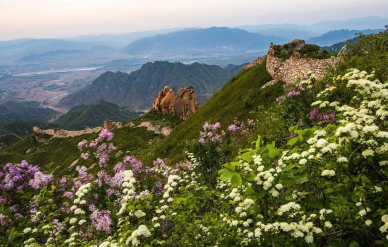
Syringa Valley, Badalinga National Forest Park
Zhangjiajie National Forest Park is about the harsh beauty of the mountains and old-growth forests protected by UNESCO as the grand heritage of antiquity. Its vast territory, which comprises 48,000 hectares in Hunan Province, is an endless massif overlooking the stunning nature from the viewing decks. During a cable car ride, you may feast your eyes on pillar-like peaks — the most spectacular spots.
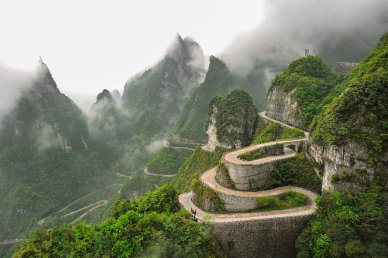
Zhangjiajie National Forest Park
The Chinese have always been real aesthetes; that is why they have given beautiful and poetic names to the places and localities. For example, the Chengde Mountain Resort, or a cool summer shelter, is the palace and residence of the Qing emperors in Hebei. A marvelous sight has comprised fancy constructions, arbors, emperors’ private chambers surrounded by fabulous gardens.
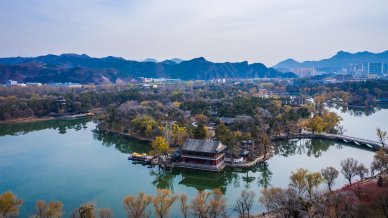
Chengde Mountain Resort
The places mentioned above constitute only a small part of attractions that can be seen in China. The country of millennial history thoroughly keeps everything connected to its great past and cordially invites the guests to see its sightseeing attractions.
Food
Food has become not only the means to sate hunger but a whole science of health and longevity, to which the Chinese have devoted many treatises of antiquity.
Being a chef has always been a very honourable and prestigious occupation. In ancient times, there was a belief that the skill of cooking was tantamount to the skill of ruling a state. It is known that Emperor Shang appointed one of his chefs the Prime Minister of the country.
Nowadays, Chinese cuisine is a bright combination of cooking traditions stemming from all the regions. The four main varieties are Sichuan, Cantonese, Shandong, and Jianshui, but there are eight directions in total.
Chinese cuisine is world-known due to the Cantonese dishes. For example, century eggs — an appetizer made of duck, chicken, or quail eggs and cooked for several months — have become a true legend.
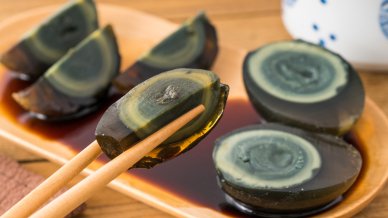
Century eggs, a traditional Chinese dish
Fresh eggs have to be smeared with a mixture of lime, clay, ashes, and some other ingredients and then put into a basket of thatch to be dug in the ground for a period that ranges from three weeks to three months.
Egg white does not have any access to air, so it changes its colour and consistency into thick brown jelly. Yolk remains creamy but changes the colour from yellow to different shades of gray and black.
The cooked century eggs do not have a pleasant aroma because they smell like ammonia. However, those who are risky enough to have tasted the snack claim about its zest — it remains a tender duck pate with a hint of cheese.
There are no intricacies of consuming such a dish: peel it as an ordinary egg and eat.
Fried rice is a delicious garnish and a separate dish. There are many ways to cook it: some chefs begin with boiling rice and then fry it, adding vegetables and green stuff. The others prefer frying the dry rice in oil till brown, and only then, they start boiling it with vegetables to get a crispy vegetable pilaff.
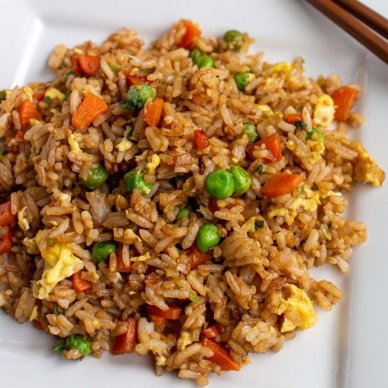
Chinese spicy vegetable fried rice
The category of soups evokes much interest too. They are not the main course and differ from ordinary European soups completely. The procedure of their cooking in China is time-consuming. The meat or seafood broth should be boiled for several hours, and then it is complemented with mushrooms, pumpkin pieces, herbs, and spices. Though unusual, the dish ends up very flavorous in the end.
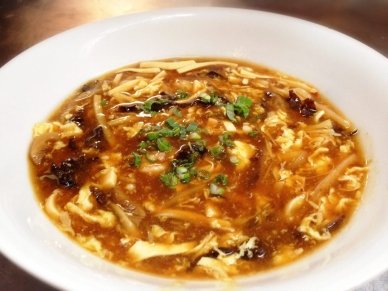
Chinese sweet and sour seafood soup
The Chinese like everything deep-fried, be it fish balls, youtiao strips, or pieces of chicken meat. The main thing is a mouth-watering crunchy crust and a dipping dish with a delicious sauce put next to it.
In Chinese cuisine, sauces are peculiar sorts of spices added to meat, fish, seafood, and desserts. There are dozens and even hundreds of their types, each of which intends for a particular dish.
Apart from the well-known and extremely popular across Asia organic soy sauce, in China, they serve sweet-and-sour, oyster, plum, ginger, and honey sauces. Their main attribute is an excellent balance of flavours and aromas, achieved by mixing a certain quantity of ingredients.
The Chinese have the reputation of adventurous eaters. It is believed that they can cook and eat everything, be it a cockroach or a dog.

A plate of cockroaches served at a restaurant in Yibin City, Sichuan Province, China.
It is true to some extent. Certain species of insects are bred at farms and then deep-fried and served everywhere as ordinary street food. They resemble fried sunflower seeds very much, and it is almost impossible to put them down.
Not only do Koreans eat dog meat. In China, the restaurants serving such exotic food are everywhere. Europeans and Americans get shocked and feel resentful about this fact. But it is necessary to understand the mentality of the Chinese: their attitude towards dogs does not differ from the attitude towards any other animals. So if it is good to eat, why not consume?
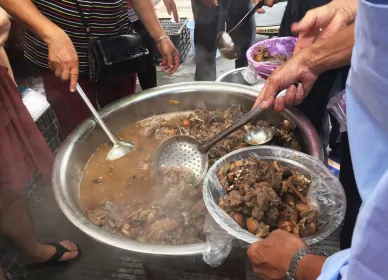
Dog meat served at a restaurant in Yulin
The other exotic dish of Chinese cuisine is frog’s legs served with various sauces. Though the delicacy is eaten not only in France, for some reason, only the French are called frog-eaters. The food resembles tender chicken, so delicious that it is worth giving it a try.

Chinese fried frog legs
China is a miraculous country. It excites, shocks, and charms. It impresses with century-old traditions and outstanding success in all spheres. In China, there live incredibly hard-working and full-hearted people, creating their bright future right now.
FAQ
What is the old name of China?
Historically, China was known as the "Middle Kingdom" or “Zhongguo” in Mandarin.
What is China's official full name?
The official full name of China is the People's Republic of China (PRC).
What is the exact area of China?
China covers an approximate area of 9.6 million square kilometers, making it the fourth largest country in the world by area.
What is China's capital?
The capital of China is Beijing.
What is the current population of China?
China has the world's largest population, exceeding 1.4 billion people.
Why is China's population so large?
China's large population is attributed to its vast geographical area, a long history of agricultural civilization, and historically high birth rates, although these have decreased in recent decades.
What are the 3 main Chinese languages?
The three main languages in China are Mandarin (official language), Cantonese, and Shanghainese.
Does China have a strong economy?
Yes, China has one of the world's largest and fastest-growing economies, with a significant role in global trade and manufacturing.
What is China's currency called?
The currency of China is the Renminbi (RMB), with the primary unit being the yuan (CNY).
What are the largest cities in China?
The largest cities in China include Shanghai, Beijing, Chongqing, Guangzhou, and Shenzhen.
What type of government is used in China?
China is governed as a single-party state under the leadership of the Communist Party of China (CPC).
Is China a communist country?
Yes, China is a communist country, with the Communist Party being the sole governing political party.
Who are China's neighbors?
China shares borders with 14 countries: Afghanistan, Bhutan, India, Kazakhstan, Kyrgyzstan, Laos, Mongolia, Myanmar (Burma), Nepal, North Korea, Pakistan, Russia, Tajikistan, and Vietnam.
How is the environment of China?
China has diverse environmental regions, but it faces significant environmental challenges, including air and water pollution, deforestation, and desertification.
What is China most known for?
China is known for its ancient civilization, Great Wall, cultural heritage (like Confucianism and Taoism), economic growth, and as a major global political and economic power.
Do China have good human rights?
China has faced international criticism regarding its human rights record, including issues of freedom of speech, press, assembly, and concerns about the treatment of ethnic minorities.
Is China a good country to live?
Living conditions in China vary widely by region. While some enjoy a high standard of living and economic opportunities, others may experience challenges related to pollution, government restrictions, and social inequality.
Is China tourist-friendly?
China is a popular tourist destination known for its historical sites, but traveling can be challenging due to language barriers, cultural differences, and strict regulations.
Is a visa required for China?
Yes, most travelers require a visa to enter China. Visa policies vary based on nationality and the purpose of the visit.







